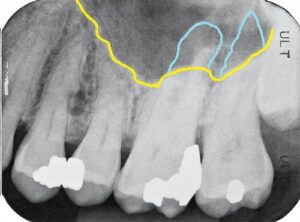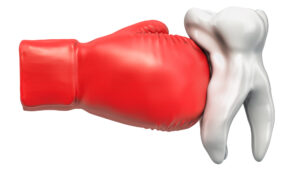Why Does My Tooth Hurt?
 There are many reasons that teeth can hurt, and they are not all dental infections. Since most people are familiar with the concept of toothaches from large cavities that lead to abscesses, we will limit this article to covering the non-infectious causes of tooth pain. These are the potential underlying problems when a dental exam or x-ray shows that there is “nothing wrong” with the tooth.
There are many reasons that teeth can hurt, and they are not all dental infections. Since most people are familiar with the concept of toothaches from large cavities that lead to abscesses, we will limit this article to covering the non-infectious causes of tooth pain. These are the potential underlying problems when a dental exam or x-ray shows that there is “nothing wrong” with the tooth.
Cracked Tooth Syndrome
Most people do not realize that a cracked tooth does not show up on an x-ray. There are two reasons for this. First, a crack in a tooth typically runs vertically from the biting surface of the tooth toward the root. X-rays capture a two-dimensional image, which does not show the particular dimension of a tooth fracture. Second, the crack would have to be so advanced that the tooth is separating in order for it to show up on an x-ray. By that time, we usually cannot save the tooth.
Some tooth cracks result from injuries to the face, but most come from heavy clenching and/or grinding forces that add up over time. Patients who show evidence of clenching or grinding and do not wear a protective nightguard are at a high risk for cracked teeth.
What Does It Feel Like?
Most cracked teeth, when caught early enough for treatment, cause sensitivity to cold and pain on chewing. The chewing pain usually occurs as a sharp zing that you can isolate to a single tooth. Your dentist has tools to diagnose a cracked tooth, including a bite-stick test and a high-powered light for transillumination.
How Do We Fix It?
Cracked teeth are tricky because cracks can change very quickly. One bite, and the crack can spread down into the root, making any treatment questionable. The best-case scenario is catching the crack in its earliest stages. In early cracks, your dentist can cover the tooth with a crown, completely replacing the cracked enamel. When the crack causes irreversible inflammation in the nerve within the tooth, a root canal is necessary, in addition to the crown.
Cracks that reach the root have a hopeless prognosis, so your dentist will discuss options of replacing the tooth after extraction.
Referred Pain from Inflamed Sinuses
 Upper molars and premolars can suffer from referred pain due to pressure in the sinus cavity, which rests just above the tips of their roots. When there is sinus pressure caused by inflammation or infection (Hello, allergy season!), it can also put pressure on the nerves entering each tooth.
Upper molars and premolars can suffer from referred pain due to pressure in the sinus cavity, which rests just above the tips of their roots. When there is sinus pressure caused by inflammation or infection (Hello, allergy season!), it can also put pressure on the nerves entering each tooth.
What Does It Feel Like?
This type of pain is more vague, meaning it doesn’t feel isolated to a specific tooth. The teeth in the area may be sensitive to cold. It probably hurts to chew or tap on the side of the tooth. Many people note that they have increased pain when the run or jump because of the impact with the ground. There is also pain when you hang your head upside down (as many people do to dry their hair).
How Do We Fix It?
The good news is that this type of pain requires no dental treatment. We typically recommend over-the-counter antihistamines and decongestants to relieve the pressure in the sinus cavities. If the pain persists after taking over-the-counter medications, you might need to see your medical doctor to rule out an infection and the need for antibiotics.
Nerve Problems (i.e. Trigeminal Neuralgia)
This is the most difficult type of atypical tooth pain to treat. When there is a problem along a nerve, the signals that nerve sends to the brain can go haywire. This malfunctioning can convince your brain that you absolutely must have a huge cavity in that tooth.
There are specific conditions that can refer pain to the teeth, like Trigeminal Neuralgia. There are also vague neuropathies that could result from impingement on a nerve by a cyst or compression in the jaw joint or cervical spine. The possibilities are almost endless, which makes diagnosis rather difficult.
What Does it Feel Like?
Because nerves provide all of our sensations, a problem with a nerve can run the gamut of sensations. Often people describe burning or zinging types of pain when nerves are involved. Some experience a “normal” toothache.
Pain that you cannot consistently stimulate by certain actions like chewing or drinking ice water may be nerve-related.
How Do We Fix It?
Achieving the proper diagnosis is the first and most important step. Dr. Ann may choose to work with a neurologist to accurately identify the source of your pain. Some doctors use specific medications that help “turn off” nerves. Others will use physical therapy or surgery to remove pressure from impinging on a nerve.
Bruised Periodontal Ligament
 A bruised periodontal ligament (PDL, for short) occurs when a tooth receives heavy forces during an injury, from heavy clenching or grinding, or inadvertently biting onto something extremely hard. The PDL is the tiny ligament that connects the tooth to the bone. It acts as a shock absorber, and it does contain both nerves and blood vessels. When a tooth receives an overly heavy force, it can suffer a bruised PDL due to inflammation in the area surrounding the tooth.
A bruised periodontal ligament (PDL, for short) occurs when a tooth receives heavy forces during an injury, from heavy clenching or grinding, or inadvertently biting onto something extremely hard. The PDL is the tiny ligament that connects the tooth to the bone. It acts as a shock absorber, and it does contain both nerves and blood vessels. When a tooth receives an overly heavy force, it can suffer a bruised PDL due to inflammation in the area surrounding the tooth.
What Does it Feel Like?
Usually a bruised PDL will have a dull ache and some pain or tenderness on chewing. Unlike a cracked tooth, it will usually not have a zing-type sensation. Instead, most people describe it as a deeper tenderness since the source of the pain is around the tooth and not in the tooth.
How Do We Fix It?
Most bruised PDLs will resolve on their own with no need for dental treatment. For instance, if you bite down on a piece of metal in your food and then suffer from tenderness on that tooth, you can assume you have a bruised PDL. Since the cause of the bruise was a one-time incident, nothing needs to change.
However, some people can suffer a bruised PDL because they have an unbalanced bite, with one tooth receiving too much force during normal function. In a case like this, that one tooth would require adjustment to the bite.
More Questions about Tooth Pain?
Call Designer Smiles today and schedule a consultation with Dr. Ann. She is an excellent diagnostician and can determine the cause of your pain during a thorough evaluation of the situation. Then, together, you can work out the best treatment from the options she presents.
